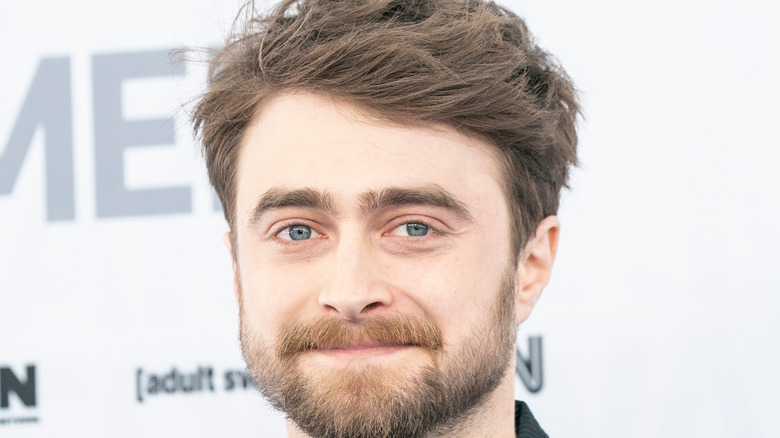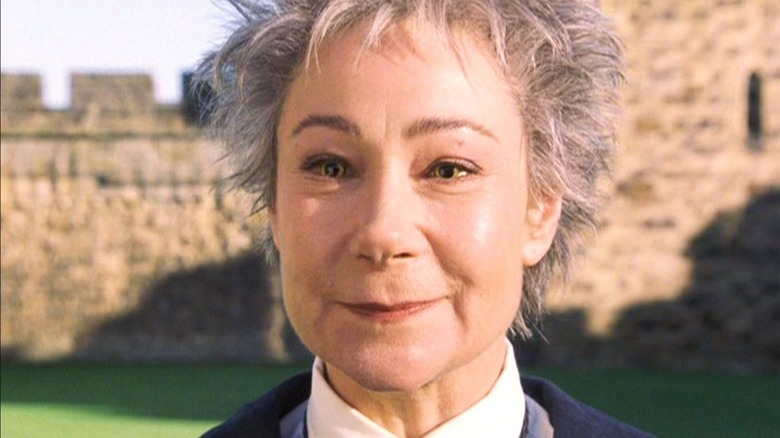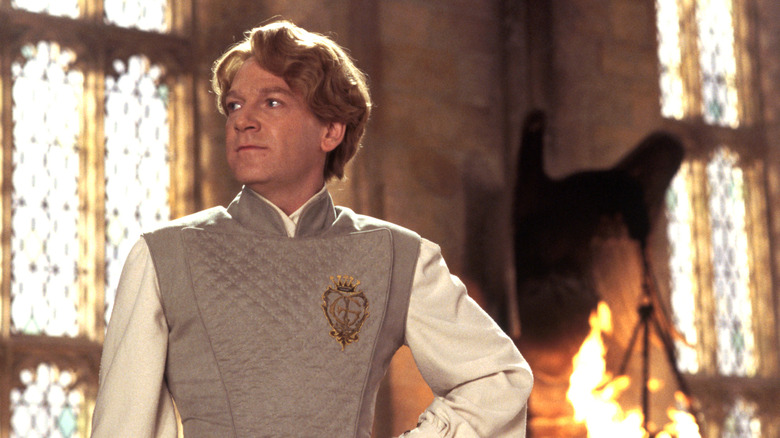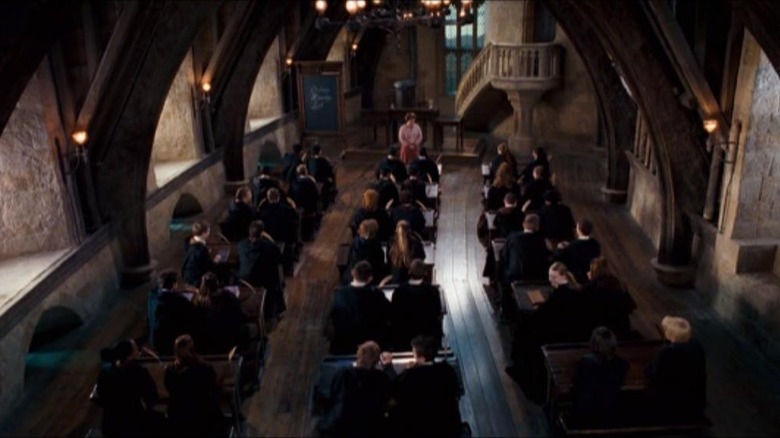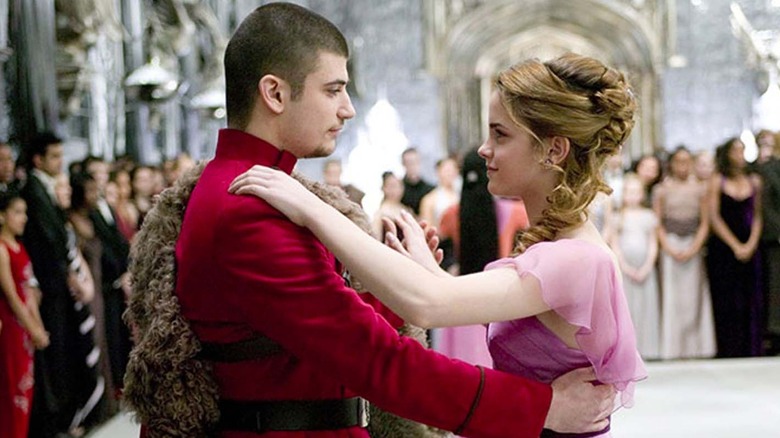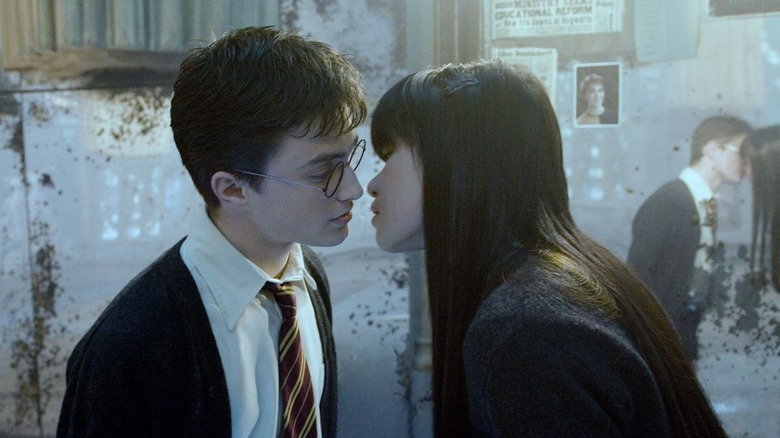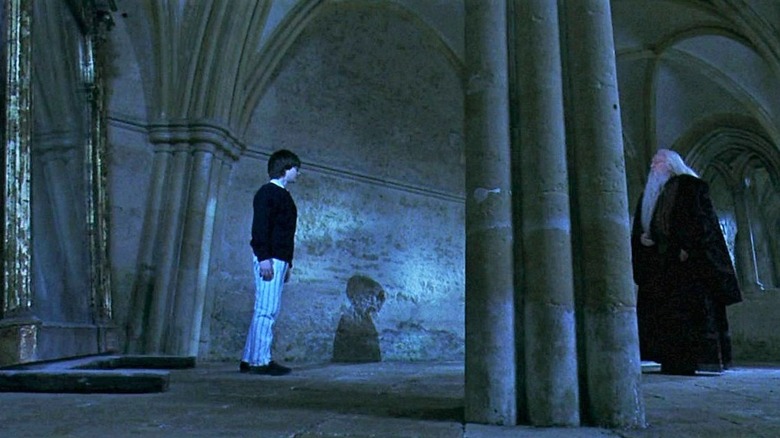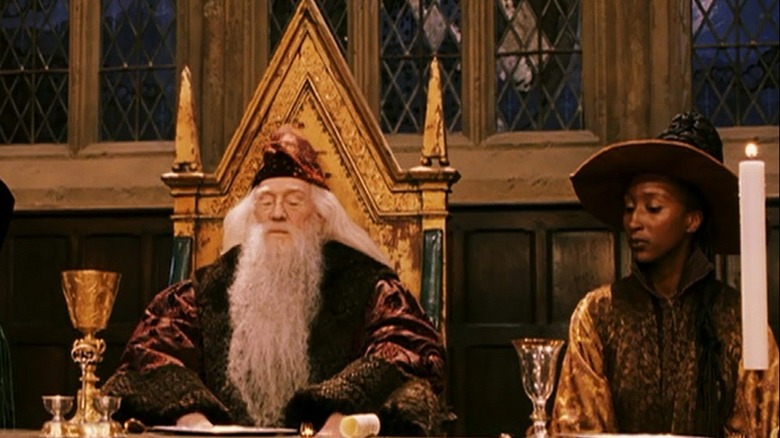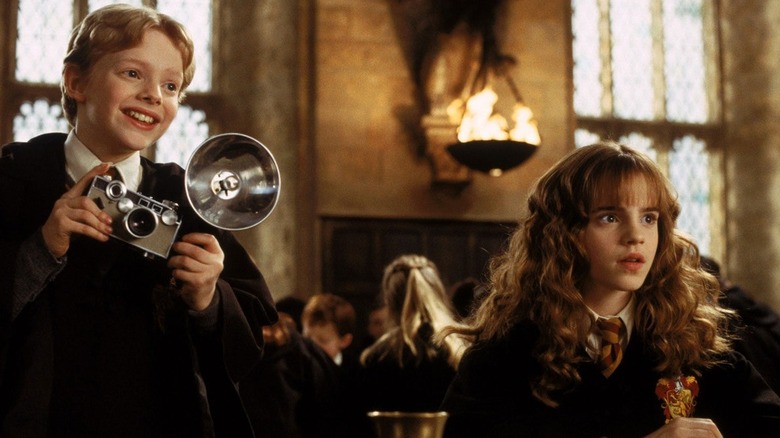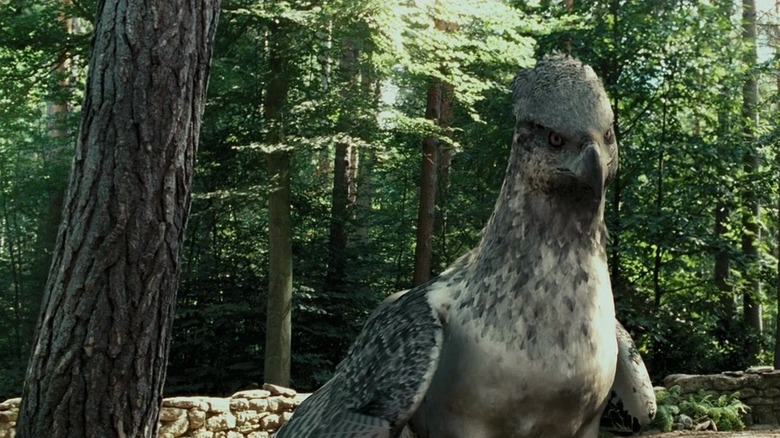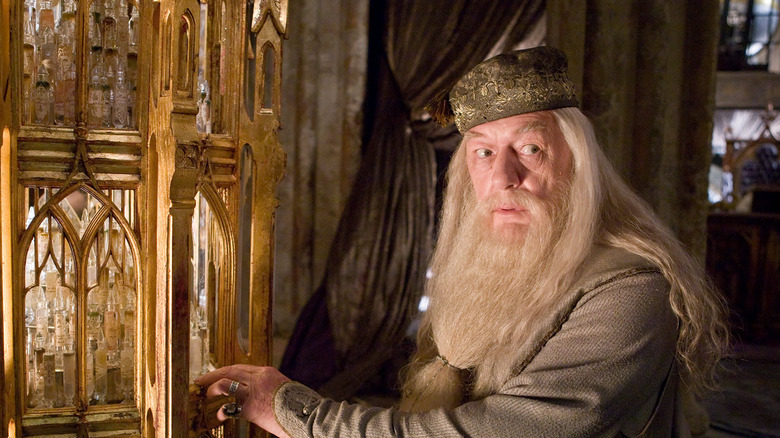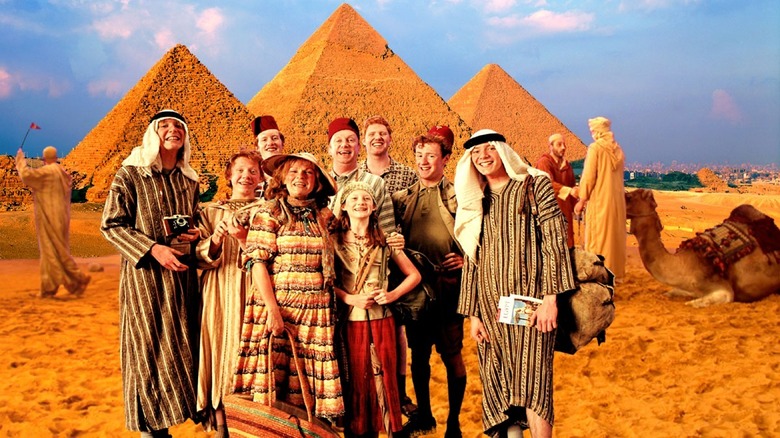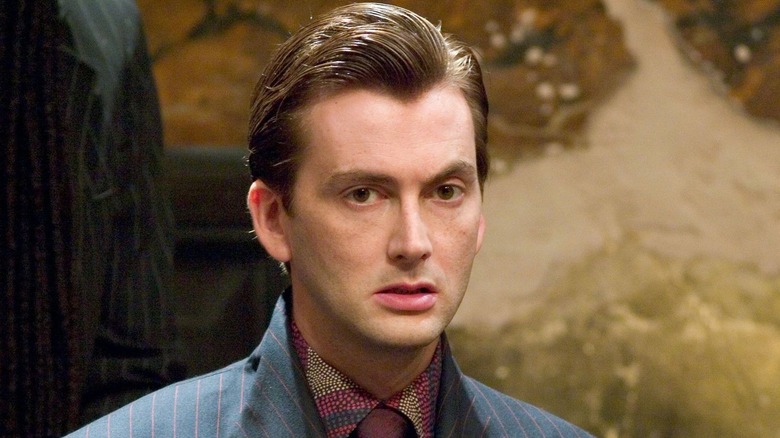Harry Potter Storylines That Disappeared Without Explanation
The story of Harry Potter is, at this point, deeply ingrained in popular culture. A coming of age tale, the Boy Who Lived's arc is the classic hero's quest: Harry is plucked from an ordinary world and whisked away to the magical Hogwarts School of Witchcraft and Wizardry, where he learns all the lessons he needs to defeat the Dark wizard, Lord Voldemort, and stop his tyrannical reign of terror. Along the way, Harry has his best friends, Ron Weasley and Hermione Granger, to help him, while accumulating more mentors and father figures than Arya Stark from "Game Of Thrones." Each of these mentors — Sirius Black, Professor Dumbledore, Hagrid — help shape Harry into a hero capable of overthrowing the darkest wizard of all time.
"Harry Potter" isn't a story solely about Harry, however. Hogwarts could be considered the series' most vibrant character. The school breathes life into the story, while playing host to a plethora of colorful supporting characters, from staff to students. Like most fantasy series, the "Harry Potter" books feature a complex mythos and world-building galore. The films tried their best to be faithful; they mostly succeeded. But several storylines slipped through the cracks during the transition to the big screen, showing up briefly only to later disappear from the narrative altogether.
Fans of "Harry Potter" have been vocal about what moments from the books should have been featured in the films, such as the Quidditch Cup, Peeves the poltergeist, and Hermione's pro-house elf movement S.P.E.W. But what moments did make it into the movies, only to take an impromptu trip through the Vanishing Cabinet later on? Let's find out.
Madam Hooch only appears in the first film
Madam Hooch appears in "Harry Potter and the Sorcerer's Stone," in a small but significant moment for the Boy Who Lived. Played by Zoe Wanamaker, Hogwarts' resident Quidditch coach teaches flying lessons to the first-year students. Harry (Daniel Radcliffe) rides a broomstick for the first in Madam Hooch's class. Additionally, Harry's flying lesson features another moment of child endangerment when Neville Longbottom (Matthew Lewis) falls from a rogue broomstick and breaks his wrist. What did you expect from a school with its very own haunted forest on campus?
Everything works out for Harry after he chases Draco Malfoy (Tom Felton) to retrieve Neville's Remembrall. Professor McGonagall (Maggie Smith) observes Harry's natural prowess in the air, and gives him a position as Seeker for Gryffindor's Quidditch team. Madame Hooch can be seen refereeing Harry's first match against Slytherin, where he almost swallows the Golden Snitch. After "Sorcerer's Stone" though, Madam Hooch disappears. The character is absent from the rest of the films, despite her role in the books as a flying instructor and Quidditch coach. Actor Zoe Wanamaker only signed on for one film, which is likely why Madam Hooch disappears from the story after "Sorcerer's Stone."
Where did Gilderoy Lockhart go?
Another character to only feature in one film in the "Harry Potter" series is Gilderoy Lockhart (Kenneth Branagh). Harry's second Defense Against The Dark Arts professor is, arguably, his most inept. Appearing in "Harry Potter and the Chamber of Secrets," Lockhart is a charismatic, charming celebrity renowned for successfully banishing various dark creatures. Harry meets Lockhart in the wizarding book shop Flourish and Blotts; Lockhart insists on having a photograph taken of him and Harry while promoting his autobiography to a crowd of fans (including a smitten Mrs. Weasley).
Lockhart is all style and no substance. His lessons at Hogwarts expose him as a fraud, and he admits at the end of the film that he's taken credit for other people's work throughout his career. "Chamber of Secrets" culminates with a Memory Charm backfiring on Lockhart thanks to Ron's broken wand. Lockhart gets a taste of his own medicine, losing all memory of who he is.
In the films, Lockhart isn't seen again after "Chamber of Secrets." This contrasts the book, in which Harry, Ron and Hermione run into an amnesiac Lockhart in St. Mungos Hospital For Magical Maladies and Injuries during "Harry Potter and the Order of the Phoenix," while visiting Arthur Weasley. Lockhart's appearance is a brief cameo, though a nice call-back to "Chamber of Secrets."
Harry stops going to lessons
The classes at Hogwarts School of Witchcraft and Wizardry were the dream curriculum of every "Harry Potter" fan. Flying lessons, Transfiguration, Charms, Defense Against The Dark Arts ... why exactly does Harry complain about schoolwork in the books again? He's learning how to use magic!
Envious rant aside, Harry doesn't seem to attend many classes throughout the films, or at least not on-screen. "Sorcerer's Stone" and "Chamber of Secrets" include more of Harry's lessons from the books. From "Prisoner of Azkaban" onwards, however, Harry's classes take more of a backseat in favor of the growing drama at Hogwarts and beyond.
The boy wizard's lessons tend to appear only when something significant happens: Harry's flight on Buckbeak in "Prisoner of Azkaban," Moody explaining the Unforgivable Curses in "Goblet of Fire," Harry winning a vial of Felix Felicis in "Half-Blood Prince," etc. The books have more space to explore Harry's journey, while in the films Harry uses several spells seemingly out of the blue with no prior classroom practice.
Viktor Krum and his relationship with Hermione
"Harry Potter and the Goblet of Fire" is a turning point in the story for everyone's favorite teenage trio. Harry, Ron and Hermione begin to transition from children to adults, journeying through puberty in a pretty perilous era for the wizarding world. Lord Voldemort (Ralph Fiennes) makes his comeback at last, emerging from a cauldron with no nose and a thirst for blood. All in all, "Goblet of Fire" is a bleak period for the heroes. Ron and Hermione argue, Ron and Harry argue, Harry nearly dies again, and Voldemort returns.
But it's not all bad for the Golden Trio, especially Hermione. The intellectual witch meets Quidditch sensation and Durmstrang student, Viktor Krum (Stanislav Ianeski), when Hogwarts hosts the Triwizard Tournament. Hermione's romance with Krum is brief — and largely ruined by Ron's jealousy — but ends sweetly, with Krum asking Hermione to write to him after he leaves.
In the books, Hermione mentions Krum periodically after "Goblet of Fire." The two establish a friendship as pen-pals. Krum returns in "Deathly Hallows" as a guest at Bill Weasley and Fleur Delacour's wedding: The Bulgarian Seeker shares a dance with Hermione, provoking Ron to dance with her instead. The films omit Krum's role for the most part following "Goblet of Fire," awarding more focus to Hermione's relationship with Ron.
Harry and Cho Chang's relationship
Like Hermione, Harry has a love interest in "Goblet of Fire:" Cho Chang (Katie Leung). The Ravenclaw student initially rebuffs Harry for Cedric Diggory (Robert Pattinson). After Cedric dies, however, Harry grows close to Cho while defying Umbridge's regime and teaching her and the rest of Dumbledore's Army defensive magic in "Order of the Phoenix." Harry shares his first kiss with Cho, before their budding relationship quickly goes awry.
In the film, Cho reveals the truth about the DA when Umbridge (Imelda Staunton) questions the students with Veritaserum, a potion that forces people to tell the truth. Cho is later shown trying to talk to Harry, who rejects her. This is more amicable than their break-up in the book: After kissing Cho in "Order of the Phoenix," Harry goes on a disastrous date with her at Madam Puddifoot's Tea Shop in Hogsmeade. Cho reminisces about Cedric, which angers Harry, while Cho grows jealous when Harry mentions his friendship with Hermione. Their break-up is sealed when Cho's best friend, Marietta Edgecombe, tells Umbridge about the DA and is permanently scarred with blemishes by a jinx Hermione placed on a piece of parchment the group signed.
Post-"Order of the Phoenix," Cho graduates from Hogwarts and Harry pursues a relationship with Ginny Weasley. The two are briefly reunited in "Deathly Hallows" during the prelude to the Battle of Hogwarts. The films follow a similar path, reducing Cho to a cameo character after her abrupt break-up with Harry.
The Mirror of Erised
The Mirror of Erised serves a plot purpose during "Harry Potter and the Sorcerer's Stone," then is gone. It gives Harry his first glimpse at his parents, James and Lily. Additionally, it brings Harry and Dumbledore (Richard Harris) together: Harry discovers the magic mirror while strolling around the school at night under cover of his father's Invisibility Cloak. The Mirror of Erised shows Harry his heart's desire: his parents. When Harry brings Ron to the mirror, however, his best friend sees a different vision of himself, holding the Quidditch Cup.
Dumbledore later tells Harry the truth about the mirror. In both the film and the book, the Headmaster intercepts Harry's nightly meetings with the mirror, giving the boy wizard a wise ominous warning about the mirror's dangers: "It does not do to dwell on dreams and forget to live." Dumbledore informs Harry that the Mirror of Erised is being moved to a different location. After that, the mirror is never seen again.
This storyline disappears from the books and the films; the Mirror of Erised is never returned to Hogwarts, nor does Harry ever see it again. Instead, the mirror represents an important lesson for the Boy Who Lived, as well as a test of character on his hero's quest. Harry heeds Dumbledore's advice and opts to live in the present, rather than the past.
Professor Sinistra has a brief cameo, then disappears
The "Harry Potter" films were mostly faithful adaptations of the book series, though many characters had to be cut during the jump from the page to the big screen. Multiple members of Hogwarts' faculty never appeared in the films: Professor Binns (the spectral History of Magic teacher), Professor Grubbly-Plank, and the centaur Firenze (who teaches Divination after Umbridge fires Professor Trelawney in "Order of the Phoenix"), to name a few.
One teacher who had a cameo appearance before disappearing from the film series is Professor Sinistra. Sinistra teaches Astronomy lessons throughout Harry's time at Hogwarts. In the film, she is played by an unidentified actress in an uncredited role, which was later retconned as Professor Sinistra when the actress' likeness was used in the "LEGO Harry Potter” video games.
Omitting Professor Sinistra from the other "Harry Potter" movies was a missed opportunity for the series in regards to representation. The Astronomy teacher's physical appearance isn't given in the books, though the character was portrayed by a Black woman during "Sorcerer's Stone." In hindsight, the films could have further developed Sinistra as a prominent POC character.
What happened to Colin Creevey?
Ah, Colin Creevey. Equal parts endearing, and annoying. The star-struck student appears in "Harry Potter and the Chamber of Secrets," as the Boy Who Lived's number one fan. Colin (Hugh Mitchell) is one of the students to fall victim to the Slytherin's monster, becoming Petrified by the Basilisk. Thankfully, Harry saves the day by venturing into the Chamber of Secrets to rescue Ginny Weasley (Bonnie Wright) and kill the giant snake.
"Chamber of Secrets" is the only installment in the "Harry Potter" series to star Colin Creevey. In later films, he is replaced by an original character called Nigel Wolpert (William Melling). Nigel can be seen as an amalgam of Colin's character, as well as his brother, Dennis, who appears in the books. Nigel has a happier ending in "Harry Potter and the Deathly Hallows Part Two" than his on-page counterpart: Colin is killed by Death Eaters during the Battle of Hogwarts. It is likely that Colin's death was instead given to Lavender Brown (Jessie Cave), who is killed by Fenrir Greyback (Dave Legeno) despite surviving the battle in the books.
Buckbeak flies away and is never seen again
"Prisoner of Azkaban" features some big changes for Harry, Ron and Hermione, as they face their third year at Hogwarts. New lessons are introduced, such as Professor Trelawney's (Emma Thompson) study of Divination and Care of Magical Creatures classes led by Hagrid. Both classes prove difficult in different ways: Harry rides a hippogriff in his first lesson with Hagrid, while Trelawney frequently predicts Harry's imminent death after seeing the Grim during a Divination class.
Buckbeak, the hippogriff Harry flies on, plays a small but significant role in the third installment. Draco Malfoy purposefully provokes the beast into attacking him, and Buckbeak is sentenced to death thanks to Draco's father, Lucius. Thanks to the Time-Turner, Harry and Hermione manage to rescue Buckbeak before his extinction. Harry saves Sirius Black (Gary Oldman) from the Dementors, before his godfather departs with the hippogriff, both of them fugitives from the Ministry of Magic.
In the films, Buckbeak's story ends there. The books revisit this storyline: Buckbeak is renamed Witherwings to protect his identity. The hippogriff goes into hiding with Sirius, appearing in "Goblet of Fire" when the trio meet Sirius in a cave near Hogsmeade, as well as "Order of the Phoenix," when Harry finds him in Sirius' mother's room at Grimmauld Place. Buckbeak/Witherwings has a happy ending: the hippogriff reunites with Hagrid, per Harry's request, after Sirius dies.
The life and lies of Albus Dumbledore
The final installment in the "Harry Potter" series gives fans their first look at Albus Dumbledore's childhood and subsequent murky past. Evil journalist Rita Skeeter swoops in shortly after Dumbledore's death to drag the Headmaster's name through the dirt in her revealing biography, "The Life And Lies Of Albus Dumbledore." Harry reads an excerpt in the Daily Prophet. This triggers a crisis of faith for the Boy Who Lived, as he is forced to confront the possibility that he never knew his mentor's true identity after all.
Skeeter's biography casts a shadow on Dumbledore's legacy ... but it isn't necessarily untrue. Dumbledore was friends with the Dark wizard Gellert Grindelwald (and lovers, as the "Fantastic Beasts" film series subtly suggest). The book hints at Dumbledore's dark past — particularly his sister, Ariana — before Harry learns the truth from Dumbledore's brother, Aberforth. Ariana was attacked by three Muggle boys in her youth, causing her magic to spiral out of control. Her father, Percival, went after the Muggles in retribution, earning him a life sentence in Azkaban and a sour reputation for his family. Ariana was later left in Albus' care after their mother's death, but she was killed accidentally during a confrontation with Albus, Aberforth and Grindelwald.
This revelation humanizes Dumbledore. Before "Deathly Hallows," the Headmaster is an omniscient figure, as mysterious as he is magical. Harry comes to understand his mentor's motivations in the final book. Despite this, Aberforth's explanation is omitted in the film, likely due to on-screen limitations.
The missing Weasley
Ron's older brother, Charlie, has the biggest blink-and-you'll-miss-it cameo appearance in the film series, popping up briefly in a photograph of the Weasley family on their trip to Egypt in "Prisoner of Azkaban." Besides that? Charlie is an absent member of the Weasley clan, who never appears properly on-screen. Ron mentions Charlie in "Harry Potter and the Sorcerer's Stone," briefly explaining how his brother works with dragons in Romania.
Charlie shows up a few times in the books. The wayward Weasley takes Hagrid's baby dragon, Norbert, off their hands in "Sorcerer's Stone," before returning to Hogwarts in "Goblet of Fire" as a handler for the dragons used in the Triwizard Tournament's first task. Like the rest of his family, Charlie is present at the final battle against Voldemort in "Harry Potter and the Deathly Hallows." His exclusion from the later movies suggests that his character could have been retconned out of existence as the films focused on portraying other Weasley siblings like Ginny, Bill, and Fred and George.
Barty Crouch Jr.
"Doctor Who" star David Tennant joined the long list of acclaimed British actors to feature in the "Harry Potter" series during "Goblet of Fire." Playing the villainous Barty Crouch Jr., Tennant's role in the film was altered from the source material: When Professor Moody (Brendan Gleeson) is revealed to be Barty Crouch's son under the disguise of Polyjuice Potion, Barty Crouch Jr. regales Harry with an in-depth explanation of how he was broken out of Azkaban by his parents, only to reunite with Voldemort and help him enact his plan to capture Harry. Barty's tale concludes with him receiving the Dementor's Kiss for his crimes.
The revelation that Mad-Eye Moody is really Barty Crouch Jr. is glossed over pretty quickly in the film. Crouch never explains his motivations, or receives the Dementor's Kiss. Dumbledore remarks that the Dementors "will find Azkaban's missing prisoner," and Crouch promises that he will "be welcomed back like a hero." Did Crouch return to Azkaban after that? Or did the Dementors perform their soul-stealing Kiss off-screen? It isn't clear. Crouch's storyline, like other characters in the films, disappears without closure or explanation.
